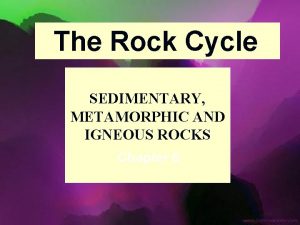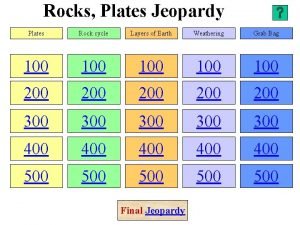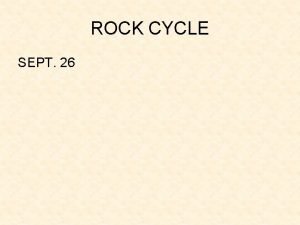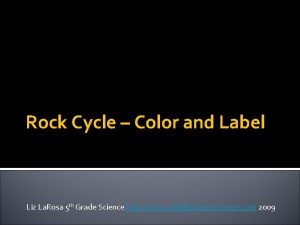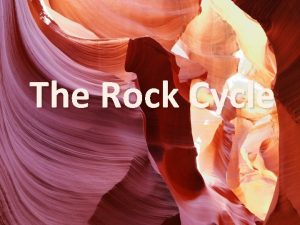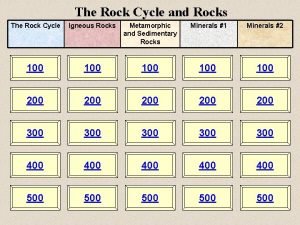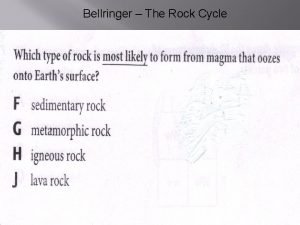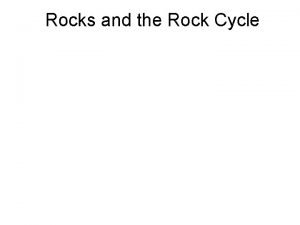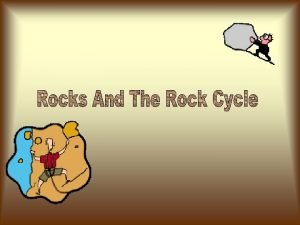The Rock Cycle What is it The rock















- Slides: 15

The Rock Cycle

What is it? The rock cycle shows how the earth's rocks are changed again and again. The rocks can be changed at times to another type of rock. The rock cycle can begin anywhere in the cycle.

3 Types of Rocks The rock cycle consists of 3 types of rocks: Igneous rock Sedimentary rock Metamorphic rock These rocks have the ability to change overtime from one type to another.

Igneous Rock The word IGNEOUS = made from fire or heat These are rocks that form directly from the cooling of magma. Often found near old volcanoes. The cooling of magma can be very slow. This results in rock that has a crystalline appearance; i. e. : granite. Cooling can also be rapid. In this case, igneous rocks will appear smooth and glass-like; i. e. : obsidian.

Igneous Rock Examples Granite Obsidian

Chocolate Bars (igneous) Chocolate bars are similar to Igneous rocks. An Igneous Rock starts as magma chocolate bar starts as liquid chocolate The magma (molten rock under the surface) and lava (molten rock on the surface) hardens into igneous rock the chocolate hardens to make the bar

Sedimentary Rock This type of rock is formed when “sediments” that have eroded from igneous rock (by weathering travel) eventually deposit into the oceans, lakes, or less frequently – land. Slowly, the big rocks settle first (heaviest), then sand then mud sinks to the bottom of the sea floor. The weight of the layers of sand water press down on the bottom layer of sand turning it into rock.

Sedimentary Rock Examples Sandstone Formations Zion National Park (U. S. A. )

Sedimentary Rock Examples Sandstone Shale Limestone

Ice Cream Sundaes (sedimentary) Consider how a Sedimentary rock formed? Overtime, layers of sediments collect on the floors of oceans to create many different layers Like the way a sundae has different layers of ice cream, sauce, fruit, whipped cream, etc. When you cut into sedimentary rock, you can see the different layers of sediment The same way you can see the layers of a sundae through a glass bowl!

Metamorphic Rock The name METAMORPHIC = “to have changed” Metamorphic rocks are rocks that have been changed in some way by heat and pressure. All of these rocks began as igneous or sedimentary rock… Sedimentary rock formed under seas may become very hot, and can change form. Red hot lava from volcanoes can change other rocks in the area into metamorphic rocks. Over time, wind and rain can wear down sedimentary rock that was exposed when land moves up. This new rock is metamorphic.

Metamorphic Rock Examples Slate Made from sedimentary shale from heat and pressure Marble Made from sedimentary limestone rock through heat and pressure

Chocolate Chip Cookies (metamorphic) Think about how is a chocolate chip cookie made? What are the ingredients? In the oven what happens? Being buried deep under the surface in areas of high temperatures and pressures or coming in contact with magma can cause these sedimentary rocks to change to metamorphic rocks. cookie dough when heated creates a hard cookie

And so, the final result of these rock formations is: The Rock Cycle

 Igneous metamorphic sedimentary
Igneous metamorphic sedimentary How can one type of rock change into another type of rock?
How can one type of rock change into another type of rock? Igneous metamorphic sedimentary
Igneous metamorphic sedimentary Rock climbing rock climbing
Rock climbing rock climbing A rock climber's shoe loosens a rock and her climbing buddy
A rock climber's shoe loosens a rock and her climbing buddy Chapter 3 standardized test practice answers
Chapter 3 standardized test practice answers Where are igneous rock found
Where are igneous rock found Rock cycle comic strip
Rock cycle comic strip Rock cycle song (sedimentary igneous metamorphic)
Rock cycle song (sedimentary igneous metamorphic) Sedimentary rock properties
Sedimentary rock properties Rock cycle jeopardy
Rock cycle jeopardy Types of rocks
Types of rocks Rock cycle example
Rock cycle example Kesler science water cycle answer key
Kesler science water cycle answer key Rock cycle foldable
Rock cycle foldable Label rock cycle
Label rock cycle








